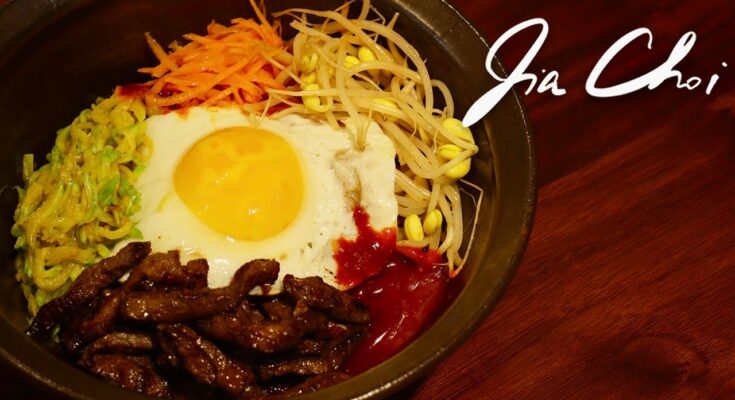Bibimbap Recipe: Bibimbap is a vibrant, hearty Korean dish that translates to “mixed rice.” Packed with a delightful array of vegetables, protein, and a spicy-sweet sauce, this dish is as much a feast for the eyes as it is for the palate.
Originating from Korea’s traditional culinary heritage, Bibimbap has become a global sensation thanks to its versatility and health benefits.
Whether you’re a novice or a pro in the kitchen, this step-by-step guide will help you prepare a mouthwatering Bibimbap at home.
Ingredients Required
Key Ingredients
- 2 cups of cooked white rice (or brown rice for a healthier twist)
- 1 cup of spinach, blanched
- 1 medium-sized carrot, julienned
- 1 cup of bean sprouts, blanched
- 1 zucchini, thinly sliced
- 100 grams of shiitake mushrooms, sliced
- 100 grams of ground beef or protein of choice
- 1 large egg
- 2 tablespoons of sesame oil
- 1 tablespoon of vegetable oil
Optional Ingredients
- Red bell peppers
- Kimchi
- Seaweed strips (gim)
- Sesame seeds for garnish
Choosing the Right Rice
The base of a good Bibimbap is perfectly cooked rice. Short-grain white rice is traditional, but feel free to experiment with brown rice or even cauliflower rice if you’re going low-carb.
Preparing the Vegetables
Common Vegetables Used
Spinach, carrots, zucchini, bean sprouts, and mushrooms are traditional choices for Bibimbap. These vegetables provide a variety of textures and flavors, making the dish a delightful experience.
How to Slice and Season Vegetables
- Slice carrots, zucchini, and mushrooms thinly for even cooking.
- Season each vegetable separately with a pinch of salt and sesame oil to enhance their natural taste.
Tips for Sautéing Vegetables
- Heat a small amount of sesame oil in a skillet and sauté each vegetable individually.
- Keep the vegetables tender-crisp for a fresh bite.
Preparing the Protein
Protein Options
- Meat: Ground beef or sliced chicken marinated in soy sauce, garlic, and sugar.
- Tofu: For a vegetarian twist, use firm tofu, seasoned and lightly pan-fried.
- Egg: A sunny-side-up egg adds creaminess to the dish.
How to Marinate and Cook Proteins
- For beef or chicken, marinate with soy sauce, garlic, sesame oil, and a touch of sugar for at least 15 minutes.
- Cook proteins over medium heat until caramelized and cooked through.
Vegan Alternatives
Tempeh, marinated jackfruit, or extra vegetables can replace animal-based proteins.
Making the Bibimbap Sauce
Key Ingredients
- 2 tablespoons of Gochujang (Korean red pepper paste)
- 1 tablespoon of sesame oil
- 1 tablespoon of soy sauce
- 1 teaspoon of sugar
- 1 teaspoon of rice vinegar
- 1 garlic clove, minced
Balancing Flavors
Adjust the sugar and Gochujang to make the sauce sweeter or spicier to suit your taste.
Tips for Making the Sauce
Mix all ingredients thoroughly in a bowl until smooth. Add a little water if the sauce is too thick. Taste and adjust seasoning before serving.
Cooking the Rice
How to Cook Fluffy Rice for Bibimbap
The foundation of Bibimbap is perfectly cooked rice. For best results:
- Wash the Rice: Rinse the rice thoroughly until the water runs clear. This removes excess starch, ensuring fluffy rice.
- Cook in a Rice Cooker: Use a rice cooker for convenience, following the water-to-rice ratio on the package.
- Stovetop Method: Combine 2 cups of rice with 2.5 cups of water in a pot. Bring to a boil, then cover and simmer on low heat for 15-20 minutes.
Tips for Using Brown or Cauliflower Rice
- Brown rice adds a nutty flavor and more fiber to the dish. Increase cooking time by 10-15 minutes to soften it.
- For a low-carb alternative, sauté riced cauliflower in a skillet with a touch of sesame oil for 5-7 minutes.
Arranging the Bowl
Layering Rice and Toppings
Presentation is key in Bibimbap. Start with a generous layer of rice as the base. Then, arrange the cooked vegetables, protein, and optional toppings (like kimchi or seaweed) in separate sections around the bowl.
The Importance of Presentation
A beautifully arranged Bibimbap bowl is not just appetizing; it also honors the traditional aesthetic appeal of Korean cuisine. Aim for a balance of colors and textures for an Instagram-worthy dish!
Cooking the Egg
How to Make the Perfect Sunny-Side-Up Egg
- Heat a small amount of oil in a non-stick skillet over medium heat.
- Crack the egg into the skillet and let it cook until the whites are set but the yolk remains runny. This takes about 3-4 minutes.
- For a more cooked yolk, cover the skillet with a lid for an additional 1-2 minutes.
Alternatives for Eggs in Bibimbap
- Use a poached egg for a softer, silkier texture.
- Skip the egg entirely for a vegan version and add extra avocado or tofu for creaminess.
Assembling Bibimbap
Step-by-Step Guide
- Base Layer: Start with a warm layer of cooked rice in a wide, shallow bowl.
- Add Vegetables: Arrange the sautéed vegetables around the rice in neat sections.
- Include Protein: Add your choice of cooked protein, such as marinated beef or tofu, to the bowl.
- Top with Egg: Place the sunny-side-up egg right in the center.
- Garnish: Sprinkle sesame seeds, sliced seaweed, or a drizzle of sesame oil for an extra touch of flavor.
Mixing Before Eating
To enjoy Bibimbap the authentic way, mix all the ingredients thoroughly with the sauce before taking your first bite. This ensures every mouthful is packed with a burst of flavor.
Tips for Serving and Storing Bibimbap
Best Practices for Serving Fresh Bibimbap
- Serve Bibimbap immediately after assembling to enjoy the freshness of the vegetables and the warmth of the rice.
- Offer the sauce on the side so diners can adjust the spice level to their preference.
How to Store Leftovers
- Store each component (rice, vegetables, protein, and sauce) in separate airtight containers in the refrigerator for up to 3 days.
- Reheat rice and protein before assembling a quick Bibimbap bowl. Vegetables can be served cold or warmed up slightly.
Health Benefits of Bibimbap
Nutritional Profile
Bibimbap is a nutrient-packed meal. It contains:
- Carbohydrates from rice for energy.
- Proteins from beef, tofu, or egg for muscle repair.
- Vitamins and fiber from a variety of vegetables.
Why It’s a Balanced Meal
The combination of rice, vegetables, protein, and healthy fats from sesame oil makes Bibimbap a complete meal that’s both satisfying and nutritious.
Common Variations of Bibimbap
Jeonju-Style Bibimbap
A traditional version featuring raw beef (yukhoe) and a variety of local vegetables, originating from Jeonju, Korea.
Dolsot Bibimbap (Stone Pot Version)
Served in a sizzling hot stone bowl, which creates a crispy rice crust at the bottom—a delightful texture contrast.
Fusion Bibimbap Ideas
- Mexican-Inspired Bibimbap: Use cilantro rice, black beans, and spicy salsa.
- Japanese-Inspired Bibimbap: Incorporate teriyaki chicken and pickled ginger.
Mistakes to Avoid
Common Errors When Making Bibimbap
- Overcooking vegetables: This can result in soggy textures. Keep them tender-crisp.
- Under-seasoning: Each component should be well-seasoned individually.
How to Fix Them
- If vegetables are overcooked, add a fresh garnish like shredded lettuce or sprouts for crunch.
- Taste and adjust the sauce if the overall dish feels bland.
FAQs about Bibimbap Recipe
What is bibimbap?
Bibimbap is a popular Korean dish consisting of a bowl of warm white rice topped with various ingredients including sautéed and seasoned vegetables, chili pepper paste (gochujang), soy sauce, a raw or fried egg, and sliced meat, usually beef. It’s served as a mixed meal with flavors blending harmoniously.
What are the essential ingredients for bibimbap?
The essential ingredients for a classic bibimbap include white rice, gochujang (Korean chili paste), sesame oil, soy sauce, assorted vegetables (such as spinach, mushrooms, carrots, and bean sprouts), beef, and an egg. You can customize the toppings based on your preference or dietary needs.
How do you make bibimbap sauce?
To make bibimbap sauce, mix together gochujang (Korean chili paste), sesame oil, sugar, water, and soy sauce in a bowl. Adjust the ingredients based on how spicy or sweet you prefer your sauce. This sauce is drizzled over the dish before serving to add flavor and spice.
Is bibimbap served hot or cold?
Bibimbap can be served both hot or cold, but it is traditionally served in a hot stone bowl which keeps the contents warm. The rice at the bottom gets crispy, adding a delightful texture to the dish.
Can bibimbap be made vegetarian or vegan?
Yes, bibimbap is easily adaptable for vegetarian or vegan diets. Simply omit the meat and egg, or use tofu as a protein substitute. Ensure that the side dishes, like kimchi, are vegan, as some may contain fish sauce.
What are some common variations of bibimbap?
Common variations of bibimbap include dolsot bibimbap, which is served in a hot stone pot, and yangpun bibimbap, which is served in a large brass bowl and is ideal for groups. Ingredients and toppings can vary widely, making bibimbap a versatile dish suited to many tastes.
Conclusion
Bibimbap is a flavorful and visually stunning dish that combines the best of Korean cuisine in a single bowl. Its versatility makes it perfect for customizing with your favorite ingredients, and it’s a fantastic way to enjoy a balanced meal. Whether you’re recreating a traditional version or experimenting with a fusion twist, making Bibimbap at home is an adventure worth taking.



